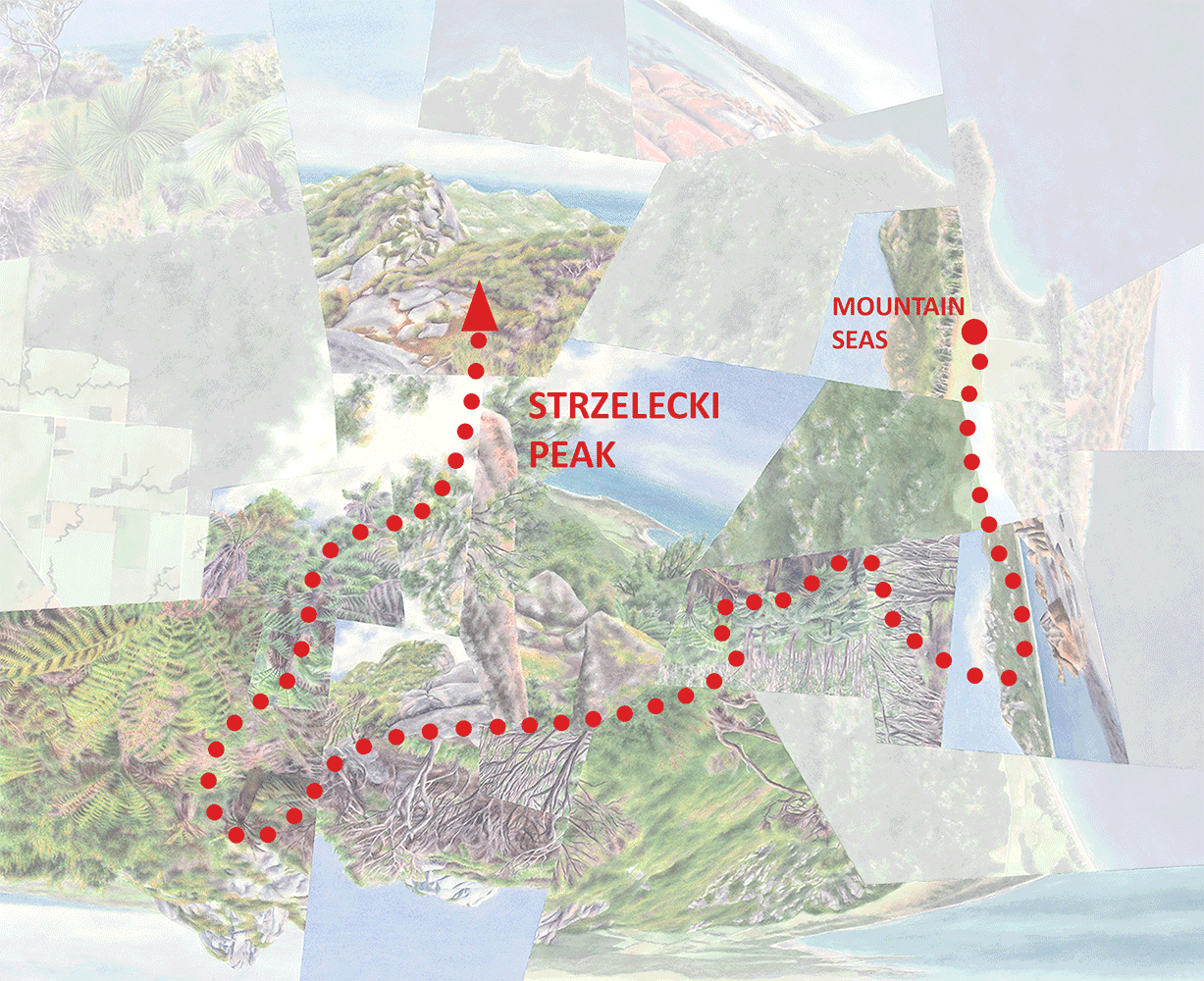My final post on “real world” climate journeys (there are still some “imaginary” examples to come!) will be a little briefer than usual since it focuses on a region that I and probably most of us have experienced much more in terms of built environments than natural ones, let alone relatively intact, native ecosystems—western Eurasia. By this I mean Europe and everything eastward to the Central Asian deserts, the latter which many fewer of us know at all from experience (myself included).
At the beginning of this series I shared a map of typical climate zones on a “generic” continent and three types of journeys or linear experiences through those zones. But that continent is actually most similar to North America: it spans all the zones from polar to tropical, and in fact assumes the presence of mountains between the three “oceanic” west coast zones and the semi-desert/desert zones just to the east. Below I’ve added a dashed white line to that diagram to indicate that set of mountain ranges—from south to north representing the Peninsular, Transverse, Sierra Nevada, Cascade, Coast, and Alaska Ranges. These ranges explain why the three west coast climate zones have a relatively narrow east-west extent and transition abruptly to the Great Basin, Mojave, and Colorado Deserts, which exist where they do in part thanks to the rain-shadow effect of those mountains.
Europe, though, has no real equivalent to those topographical barriers, except for the Scandinavian Mountains; the ranges on the Continent generally run east-west. So, the west coast climate zones—with their north-south wet-to-dry gradient, their mild winters, and (toward the north) their mild summers—extend far westward into Central Europe. The warm waters of the Mediterranean also contribute to that condition. (As in the rest of this series these general concepts are discussed in Glenn Trewartha’s The Earth’s Problem Climates.)
So traveling eastward, with no mountain barrier, the climatic influence of the Atlantic peters out gradually. And in particular the “temperate rainforest” zone (again, emphatically, these terms are generalizations…where forest still exists in Northern Europe only tiny pockets are actually that wet) of course does not give way directly to aridity but rather the marginally less rainy temperate forests of Central and Eastern Europe. (On the mainland the subpolar rainforest zone is still restricted to a narrow strip along the Norwegian coast by the Scandinavian Mountains.) So unlike in North America there’s a piece of the temperate forest zone, highlighted below, to the west of the dry regions as well as to the east. Moving even farther east, moisture from the Atlantic continues to drop off as the forests give way to the Central Asian steppes and deserts.
A revised version of the generic diagram, modified just enough to fit the Eurasian pattern; the specific locations mentioned are only examples. (If you take out the Mediterranean, you could say this version is actually closer to “generic” than the earlier one since it incorporates fewer effects of topography.)
The pattern as it actually looks, again with that anomalous temperate forest region highlighted.
Connecting the black arrows in the diagrams above, you end up with a modified, partly inverted version of the original “cross-continental” type journey. These transitions from the temperate rainforest and subtropical shrubland (Mediterranean) zones to the temperate forest zone don’t exist anywhere else in the world. Given the almost completely humanized state of the European environment they’re far from smooth or obvious; the transition between the two temperate forest types would be subtle even if it still existed to any perceptible extent. But picture the California chaparral or the Pacific Northwest rainforests fading directly into the forests of the Midwest—I think the Eurasian equivalent of that would be an interesting experience at least in theory.
I’m short on photographs (taken by me) from natural areas in this part of the world, let alone anything close to a transect, and have none from Central/Eastern Europe or eastward. But since quasi-native vegetation isn’t the focus for most of us when we go to these regions, I thought it could be illuminating to end with a few examples that I went out of my way to find….
Darren
Mediterranean fan palms (Chamaerops humilis) at San Vito lo Capo, Sicily—in cultivation they can grow into short trees, but in their rocky native habitats from Spain and North Africa to Italy they tend to stay shrub-like.
Gnarled oaks in Wistman’s Wood in Dartmoor, Devon, UK—probably classified as a little remnant of temperate rainforest.
Birch forest at Thorsmork, southern Iceland—likely wet enough to qualify as subpolar rainforest. Birch used to cover a much larger percentage of the country’s lowlands, though more shrub-like in most places.




















